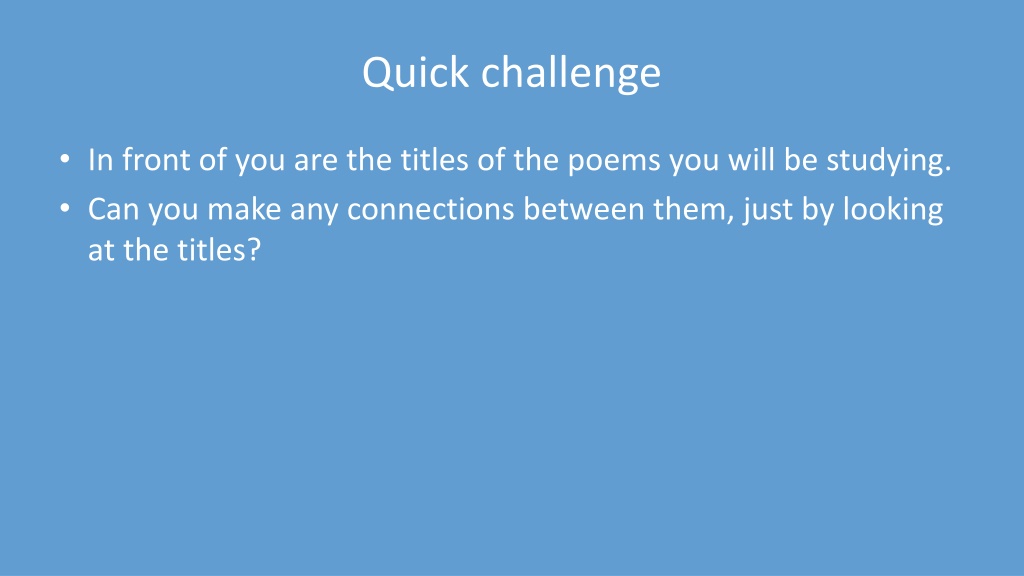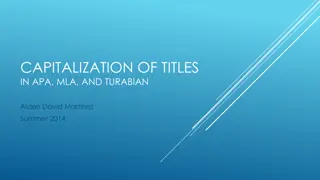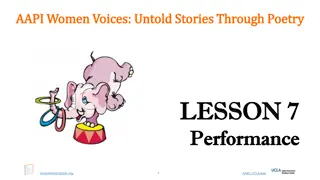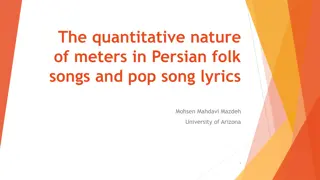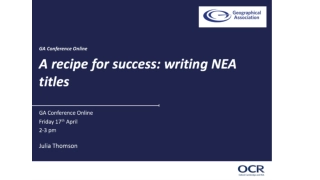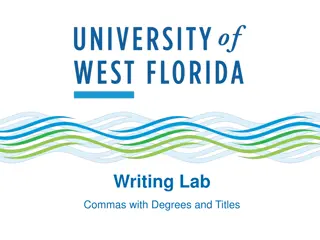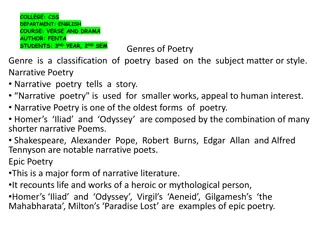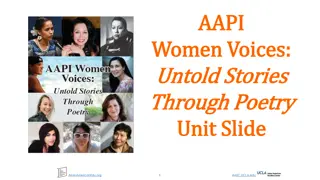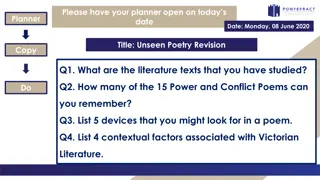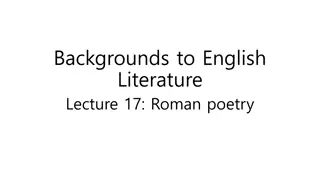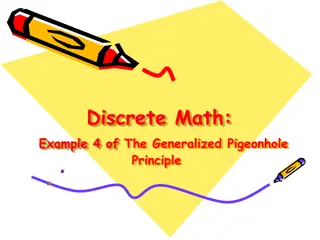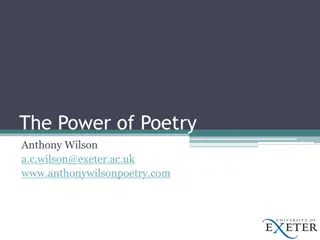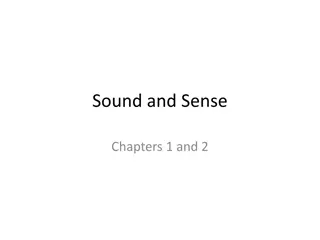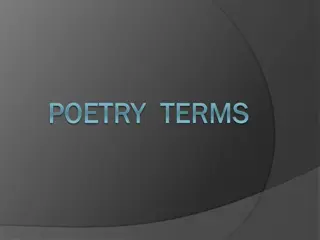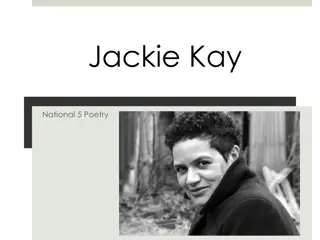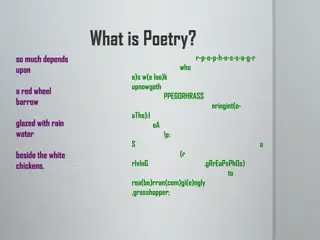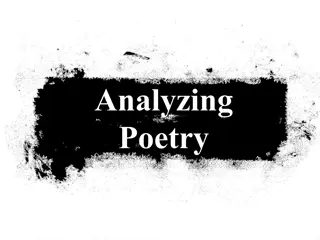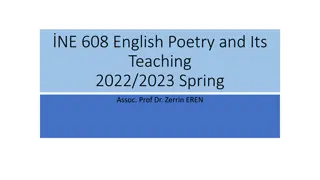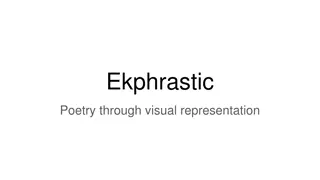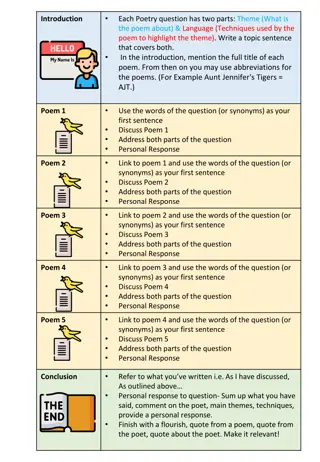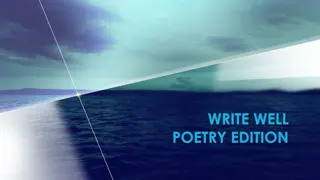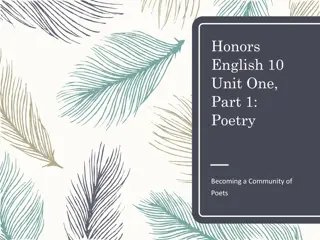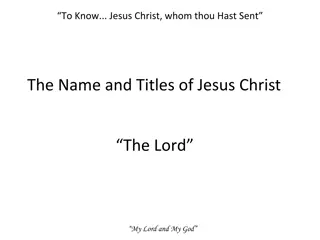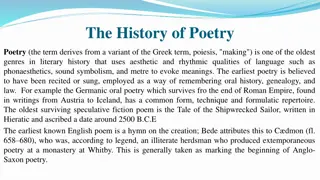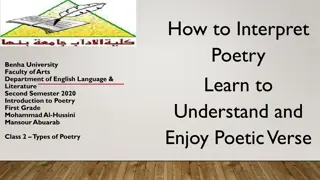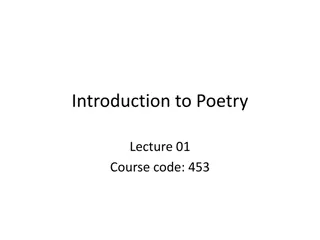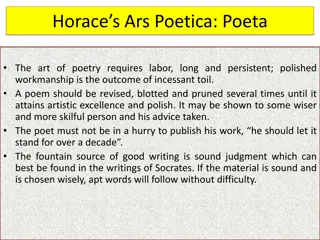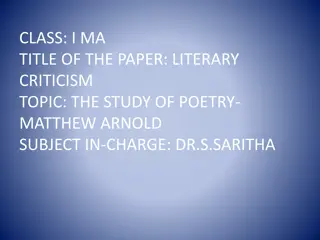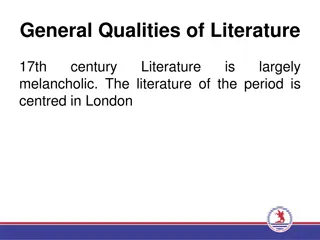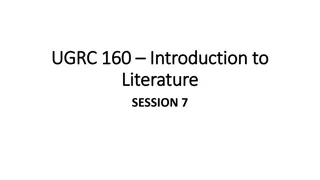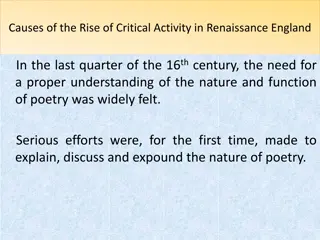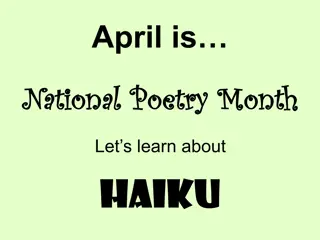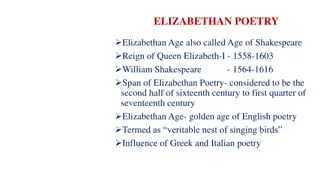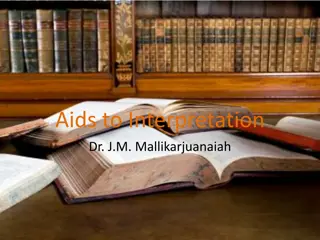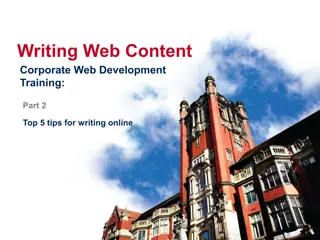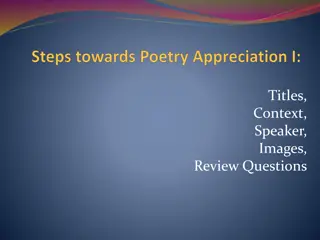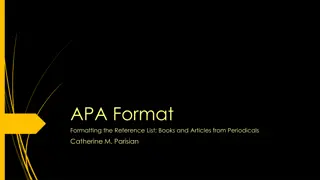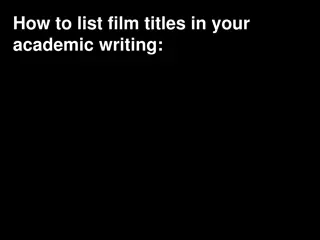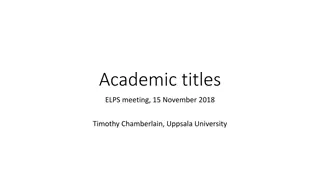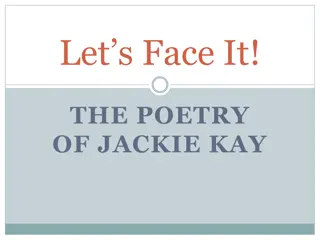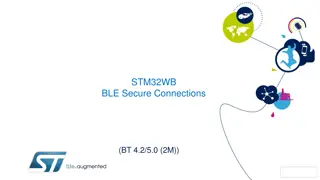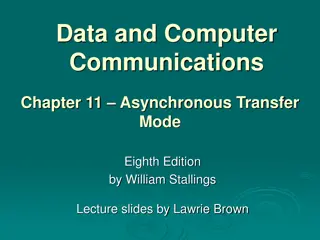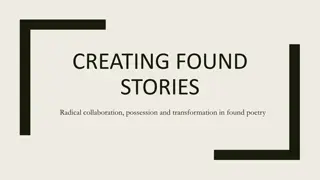Exploring Poetry: Making Connections Through Titles
In this challenge, we analyze the titles of poems to uncover potential connections between them. We delve into the reasons for writing poetry, explore the qualities of good poetry, and engage in creative tasks to deepen our understanding of poetic expression.
Download Presentation

Please find below an Image/Link to download the presentation.
The content on the website is provided AS IS for your information and personal use only. It may not be sold, licensed, or shared on other websites without obtaining consent from the author. Download presentation by click this link. If you encounter any issues during the download, it is possible that the publisher has removed the file from their server.
E N D
Presentation Transcript
Quick challenge In front of you are the titles of the poems you will be studying. Can you make any connections between them, just by looking at the titles?
Objectives: - to consider why poetry is written and what makes good poetry - to explore Agbabi s poem Eat me
Why do people write poetry? Samuel Taylor Coleridge, in Table Talk, July 12, 1827 "I wish our clever young poets would remember my homely definitions of prose and poetry; that is, prose is words in their best order; poetry is the best words in their best order." Two minutes to discuss End
Why do people write poetry? As catharsis purgation of emotions/release of pressure To convey themselves more eloquently than with prose As a remembrance of a moment/person/event/thought Due to a love of language and the endless possibilities involved in its manipulation As a challenge perhaps the most challenging form of literature in which to express yourself? What makes good poetry? POPULARITY? STRUCTURE? EMOTION? TOPIC MATTER: CONTOVERSIAL, UNIVERSAL, UNIQUE? CONTEXT DEPENDENT (PRODUCTION AND RECEPTION)?
TASK : Creative writing What makes a bad poem ? In groups of 3-4: Write the WORST poem you can in 5 minutes. Use clich , bad rhyme etc.
First poem: Eat Me (Patience Agbabi) https://www.youtube.com/watch?v=jfxPWK47eLg https://www.youtube.com /watch?v=jfxPWK47eLg EAT ME TWO MINUTES TO JOT DOWN ALL THE CONNOTATIONS THIS TITLE MIGHT HOLD Aggressive/imperative? Sexual innuendo? An insult? Fairytale allusion? About temptation?
4 step storyboard what happens in the poem? Sketch each stage on a piece of paper with a supporting quotation underneath E.g. 1. The narrator tells us of her unhealthy relationship in more ways than one
As we read, underline any lines that depict the female body What metaphors/similes are used? WHY? 5 minutes to discuss N.B: A juggernaut refers not only to a large truck but to any literal/metaphorical force that is regarded as mercilessly destructive and unstoppable Etymology: (Hindi) A huge wagon bearing the god Krishna CHALLENGE: do the kind of comparisons change throughout the poem? How does this reflect the shifting balance of power in the piece?
Key terms for today: Phonology (the sound devices used in a text) Heteroglossia (the co- existence of different voices/different linguistic styles within the same space) e.g. she uses the concept of heteroglossia in this poem to . . . In pairs, try to respond to the following questions: 1. What are some differences between the narrator and her partner s speech style? 2. Where does the partner s speech come in the poem and why might that be significant? 3. Find an example of some harsh plosive sounds here (p,t,d,g) what is the effect? 4. Find an example of some soft, long vowel sounds here what is the effect? 5. Look at the anaphora in stanza 7 why is this refrain used? 6. Find an example of alliteration what is its purpose in the poem?
Homework: 1. Read the Guardian article on the Forward anthology, highlighting key sections to help you understand why it was written imgres.jpg
Objective: - to explore another poem in the collection in which a woman s body is used as a symbol
Dont forget to FLIRT A mnemonic for poetry analysis F.L.I.R.T To Begin: Decide which features of a poem from the box on the right fall under which heading: Form Language Imagery Rhyme/Rhythm Tone Stanza length half-rhyme satirical narrator juxtaposition volta nostalgic speaker pace caesura symbolism simile assonance hyperbole quatrain
Eat Me a recap 1. Rank these statements about the poem, from the one you most agree with to the one you are least convinced by. Be prepared to explain why! - Eat Me is a poem about female empowerment - Eat Me creates a sensuous feel not only from the language used, but the sounds created - As readers, we are meant to judge the narrator - As readers, we are meant to judge her partner - Eat me blurs the lines between humour and horror 2. Write a PEAR paragraph for the point you were most convinced by. EMBED your evidence and use a key term in your analysis
P47 The Map-Woman A woman's skin was a map of the town where she'd grown from a child. When she went out, she covered it up with a dress, with a shawl, with a hat, with mitts or a muff, with leggings, trousers or jeans, with a an ankle-length cloak, hooded and fingertip-sleeved. But - birthmark, tattoo - the A-Z street-map grew, a precise second skin, broad if she binged, thin when she slimmed, a pr cis of where to end or go back or begin. 1. What technique is introduced here? What effect does it have? 2. What comment might Duffy be making about the way women dress/are expected to dress in public? 3. What is the effect of the listing here? 4. These two words are very different. How do they link/juxtapose? 5. What significance does the map have for the women, then?
VS. To conclude In his Elegy XX, the poet John Donne (famously bawdy in his early years) compares his lover's body to undiscovered territory, using the metaphor of exploration to justify his sexual conquest of the beloved: License my roving hands, and let them go Before, behind, between, above, below, O, my America, my Newfoundland So how could Duffy s poem be considered a subversion of Donne s idea? - Is the woman s map for others? - Is there any mystery in Duffy s poem?
Objectives: - to expand our knowledge of poetic terminology - to begin to make comparisons and connections between poems
To begin You have 5 MINUTES to try to fill in the first section of your glossaries (allegory compound adjective) Easy? Try to add some EXAMPLES to each definition Really stuck? Ask me for some mixed up definitions that you can match up
ALLEGORY COMPOUND ADJECTIVE A pause in a line of verse dictated by sense or natural speech rhythm rather than by metrics. The representation of abstract ideas or principles by characters, figures, or events in narrative An indirect reference Employed in conversational or informal language but not in formal speech or formal writing Two hyphenated words that contribute to a description The repetition of identical or similar vowel sounds, often in the middle of words The repetition of the same sounds or of the same kinds of sounds at the beginning of words or in stressed syllables Words and language that were once in regular use but are now relatively rare and suggestive of an earlier style or period. An expression which has become overused to the point of losing its original meaning or effect Unrhymed verse having a regular meter, usually of iambic pentameter. Uncertainty as regards interpretation Narrative poetry, with a rigid, usually rhyming structure
Evidence race! In pairs, go around the room and find evidence for the following: Evidence Idea Analysis An ominous reference to death on her living body A juxtaposition of external force and personal powerlessness Imagery of the 1960s British everytown Sibliance suggesting a desire for purgation An image of permanence and/or pain Synaesthesia A metaphor connoting preciousness An allegory for patriarchal suppression Dark humour An oxymoronic description of sounds An ambiguous list to describe her skin
Writing a comparative PEAR true or false? 1. You should only ever talk about one poem in each paragraph 2. You need to include evidence from both poems 3. You can find a link or establish a difference between the poems 4. You do not need to do as much close analysis when comparing 5. Your topic sentence should give away your comparative idea 6. You can compare audience response/poets tone/structure as well as language/themes 7. Higher grade responses will acknowledge subtle distinctions between poems
Eat me v The Map Woman In pairs, find two lines to use (1 from each poem) to illustrate these connections: 1. Both poems denounce the idea that a woman s body should be an object of pleasure for others 2. Both poems use biblical imagery, alluding to the fall and original sin 3. Both poems use descriptive detail to captivate their readers Now choose one to turn into a PEA you already have your topic sentence!
HOMEWORK: 1. ENSURE that you have thoroughly completed your table on the Map Woman 2. COMPLETE a comparative PEA on the two poems studied so far
